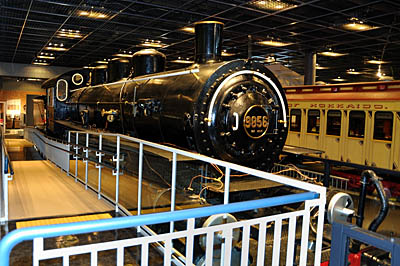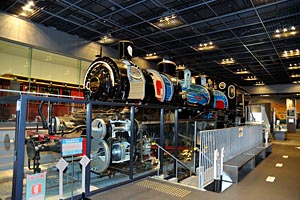
Steam Locomotive
Class 9850 |
It was an Articulated-Multiple-Cylinder type steam locomotive for banking service over Hakone pass on the Tokaido line. |

|
|
During the post Japanese-Russo War period (1904-1905) in 1910,
more powerful banker engines were needed on the Hakone pass on Tokaido's arterial line, with an increase in traffic volume. During 1911, the government railway imported six Mallet Type 0-4-4-0 tender engine Class 4600s from the American Locomotive Co on a trial basis. Mallet-Type engines were one kind of an Articulated-Steam locomotive. Usually, a steam locomotive had one cylinder on each side for a total of two cylinders operated as a one pair piston, but Mallet-Type engines had one more pair of cylinders with the driver at the fore. There was another set not fixed to the boiler and movable. Therefore Mallet-Type engines could make a tight curve in spite of it's long body. The first generated steam was used in the rear first pair of cylinders, and the discharged steam went into the next fore's second pair of cylinders. A total of four cylinders operated four pistons. During the year's following 1912, twenty-four 0-6-6-0 Class 9750 Superheated Boiler Mallet type tender engines from the American Locomotive Co., also eighteen of class 9800 from US Baldwin Locomotive Works, and twelve of class 9850 from the German builder Henschel, for a total of 54 Mallet engines were imported. Six of the last imported Class 4600s axle arrangement were remodeled to 2-4-4-0, and named to Class 9020. The total of Mallet engines were sixty.
These Mallet engines were not only on Hakone pass on the Tokaido line, but also they were used on the Otsu - Kyoto on the Tokaido line, Kuroiso - Shirakawa on the Tohoku line, Nagano - Naoetsu on the Shinetsu line and Kameyama - Kamo on the Kansai line for freight trains and pusher operations. A few Mallet engines temporarily ran between Yubari and Iwamizawa on the Muroran line Hokkaido. And in the end, almost all Mallet engines were finally concentrated at Yamakita depot for Hakone pass banker during 1922. But Mallet engine's performances were not high for their big size, and the complicated multiple-cylinder engine required extra effort for maintenance. There was no longer a need for Mallet type engines for Hakone pass pushers, when higher performance domestic produced engine class 9600 and 9900(D50) appeared. Forty-five Mallet type engines survived and the weeding out of surplus began in 1926. During 1930, all of class 9800 and 9850 were retired. Later, only twenty-three of class 9700 were left. Also 9700's were retired, when Hakone pass's quick route via Tanna tunnel was opened during 1934. |
|
Preserved engine No.9856 (1912 - 1924)
Class 9850 No.9856 exhibited in the museum was manufactured at the Henschel Co. and it's manufactured number was 11663 during 1912. After it's importation, it was deployed to the Yamakita depot and active on the Hakone pass on Tokaido main lines and banked express train services and freight train services between Kozu and Numazu. And later she was transferred to Nagano and Naoetsu on the Shinetsu line during 1915-1924.
On the 20th of March 1924, No.9856 was selected for the Railway Museum exhibition. No.9856 had an opened side view in the Omiya workshop to enable visitors to understand the inner-workings of the steam engine during 1927. And it was exhibited at the Manseibashi Railway Museum when it opened during April 1936. The engine was put on a pedestal, and the piston and driver were set up to work with a motor. Additionally, an aisle was built under the locomotive's pedestal and visitors were able to look at the engine's underside to understand the steam engine's working mechanism. During May 1976, when C57-135 was exhibited, No.9856 was taken off from the pedestal, and also the piston's working operation was stopped. But, during October 2007, when the museum moved to the Saitama new museum, No.9856 was again set up for this piston working display. |
|
Class 9850, No.9856 Biographic Data Chart
| |||||||||||||||||||||||||||
|

|  Visitors are able to look at the piston working display |
Introduction |
Go to Top |